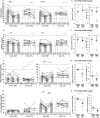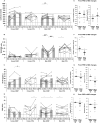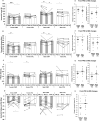Changes in hormonal profiles during competition preparation in physique athletes
- PMID: 39261323
- PMCID: PMC11829922
- DOI: 10.1007/s00421-024-05606-z
Changes in hormonal profiles during competition preparation in physique athletes
Abstract
Purpose: Physique athletes engage in rigorous competition preparation involving intense energy restriction and physical training to enhance muscle definition. This study investigates hormonal changes and their physiological and performance impacts during such preparation.
Methods: Participants included female (10 competing (COMP) and 10 non-dieting controls (CTRL)) and male (13 COMP and 10 CTRL) physique athletes. COMP participants were tested 23 weeks before (PRE), one week before (MID), and 23 weeks after the competition (POST). Non-dieting CTRL participants were tested at similar intervals. Measurements included body composition (DXA), muscle cross-sectional area (ultrasound), energy availability (EA) derived by subtracting exercise energy expenditure (EEE) from energy intake (EI) and dividing by fat-free mass (FFM), muscle strength, and various serum hormone concentrations (ACTH, cortisol, estradiol, FSH, IGF-1, IGFBP-3, insulin, and free and total testosterone and SHBG).
Results: During the diet, EA (p < 0.001), IGF-1 (p < 0.001), IGFBP-3 (p < 0.01), and absolute muscle strength (p < 0.01-0.001) decreased significantly in both sexes in COMP. Decreases in IGF-1 were also associated with higher loss in FFM. In males, testosterone (p < 0.01) and free testosterone (p < 0.05) decreased, while SHBG (p < 0.001) and cortisol (p < 0.05) increased. Insulin decreased significantly only in males (p < 0.001). Mood disturbances, particularly increased fatigue in males (p < 0.05), highlighted the psychological strain of competition preparation. All these changes were restored by increased EA during the post-competition recovery period.
Conclusion: Significant reductions in IGF-1 and IGFBP-3 during competition preparation may serve as biomarkers for monitoring physiological stress. This study offers valuable insights into hormonal changes, muscle strength, and mood state during energy-restricted intense training.
Keywords: Bodybuilding; Energy availability; IGF-1; POMS; REDs; Weight loss.
© 2024. The Author(s).
Conflict of interest statement
Declarations. Conflict of interest: V.I. works part-time as the Executive Manager of the Finnish Fitness Sports Association, which provided partial support for this research. Additionally, V.I. owns a business in the bodybuilding coaching education sector. The financial support from the Finnish Fitness Sports Association was specifically allocated to cover research-related costs, such as hotel accommodation for participants who traveled long distances and required lodging before the next day’s fasted measurements. The funders had no role in the study’s design, data collection, analysis, interpretation, manuscript writing, or the decision to publish the results. E.R. also owns a business in the bodybuilding education industry.
Figures






Similar articles
-
Weight loss induces changes in adaptive thermogenesis in female and male physique athletes.Appl Physiol Nutr Metab. 2023 Apr 1;48(4):307-320. doi: 10.1139/apnm-2022-0372. Epub 2023 Jan 16. Appl Physiol Nutr Metab. 2023. PMID: 36645885
-
Anabolic and catabolic hormones and energy balance of the male bodybuilders during the preparation for the competition.J Strength Cond Res. 2010 Apr;24(4):1074-81. doi: 10.1519/JSC.0b013e3181cb6fd3. J Strength Cond Res. 2010. PMID: 20300017
-
The Psychological and Physiological Consequences of Low Energy Availability in a Male Combat Sport Athlete.Med Sci Sports Exerc. 2021 Apr 1;53(4):673-683. doi: 10.1249/MSS.0000000000002519. Med Sci Sports Exerc. 2021. PMID: 33105389
-
Unique aspects of competitive weightlifting: performance, training and physiology.Sports Med. 2012 Sep 1;42(9):769-90. doi: 10.1007/BF03262294. Sports Med. 2012. PMID: 22873835 Review.
-
A Narrative Review on Female Physique Athletes: The Physiological and Psychological Implications of Weight Management Practices.Int J Sport Nutr Exerc Metab. 2019 Nov 1;29(6):682-689. doi: 10.1123/ijsnem.2019-0037. Int J Sport Nutr Exerc Metab. 2019. PMID: 31141414 Review.
References
-
- Ahtiainen JP, Pakarinen A, Alen M, Kraemer WJ, Häkkinen K (2003) Muscle hypertrophy, hormonal adaptations and strength development during strength training in strength-trained and untrained men. Eur J Appl Physiol 89:555–563 - PubMed
-
- Ainsworth BE, Haskell WL, Whitt MC, Irwin ML, Swartz AM, Strath SJ, O’Brien WL, Bassett J, Schmitz KH, Emplaincourt PO, Jacobs J, Leon AS (2000) Compendium of physical activities: an update of activity codes and MET intensities. Med Sci Sports Exerc. 10.1097/00005768-200009001-00009 - PubMed
-
- Allen NE, Appleby PN, Davey GK, Key TJ (2002) Lifestyle and nutritional determinants of bioavailable androgens and related hormones in British men. Cancer Causes Control 13:353–363 - PubMed
-
- Angelidi AM, Stefanakis K, Chou SH, Valenzuela-Vallejo L, Dipla K, Boutari C, Ntoskas K, Tokmakidis P, Kokkinos A, Goulis DG, Papadaki HA, Mantzoros CS (2024) Relative energy deficiency in sport (REDs): endocrine manifestations, pathophysiology and treatments. Endocrine Rev. 10.1210/endrev/bnae011 - PubMed
MeSH terms
Substances
LinkOut - more resources
Full Text Sources
Medical
Miscellaneous

